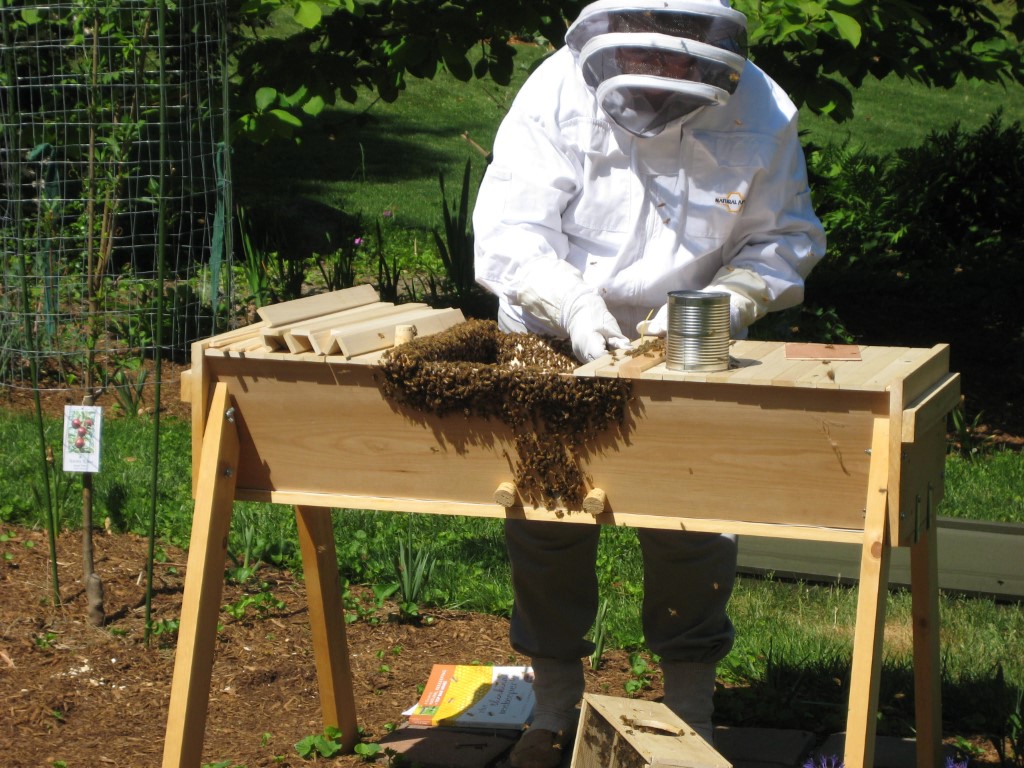What is a Top Bar Hive?
Top Bar Hives throughout history
Today’s top bar hives are the modern manifestation of an ancient and very basic beekeeping method. They are beekeeping at its simplest – a protected cavity, with bars placed across the top and spaced appropriately. A popular online depiction of one of the earliest top bar hives is known as the Greek Beehive. This image is found in The World History of Beekeeping and Honey Hunting by Eva Crane.
The design features of a modern top bar hive are based on some core facts about the needs and behaviors of honey bees:
- Bees need “bee space” – this is the space between the wax combs of the hive. It is essentially a “hallway” between combs, and its dimension is important for supporting the science of heating, cooling, and air circulation being managed by the bees inside the hive. This is crucial for raising young bees, known as brood, which must be kept at specific temperatures in order to survive. Historically, bee space is said to be 3/8”. This spacing is determined by the width of the top bars.
- Bees are “cavity nesters” – honey bees live inside cavities, or open spaces. Beekeepers invite bees to live in managed beehives, but bees see many cavities as suitable living quarters - such as hollow trees, rooflines, and walls of buildings. Any enclosed cavity with a suitable entrance, and a volume large enough for a colony to get established is fair game (according to the bees).
- Bees require “adequate volume” – researchers have studied the volume of cavities preferred by swarms of bees searching for a new home. Indications are that cavities with a minimum of 40 cubic liters of space, and an entrance of 3 square inches most often seem to meet their discerning requirements. The volume is determined by knowing the length, width, and height of the interior of the hive. Here's how to calculate the volume of a top bar hive!
These facts all influenced the design of the Gold Star Honeybees top bar beehive.
Good for the bees, good for the beekeeper, good for the planet
The Advantages of Top Bar Hive Beekeeping
Good for the Bees:
 Top bar hives are good for the bees because inside them, the bees are able to make their own clean beeswax combs from scratch, just as they have done for millions (literally!) of years. This means clean beeswax - made BY bees, FOR bees. This means your bees will avoid exposure to the chemical contamination in the foundation sheets used in other hive types. We like to melt this concept down into one easy phrase: “It’s All About the Wax!”
Top bar hives are good for the bees because inside them, the bees are able to make their own clean beeswax combs from scratch, just as they have done for millions (literally!) of years. This means clean beeswax - made BY bees, FOR bees. This means your bees will avoid exposure to the chemical contamination in the foundation sheets used in other hive types. We like to melt this concept down into one easy phrase: “It’s All About the Wax!”
Good for the Beekeeper:
 Top bar hives are good for the beekeeper because you inspect bars one at a time, so there is no heavy lifting! No heavy boxes to shift or move. No beekeeper’s back to send you to the chiropractor. The legs set the hive at the same height as your kitchen counter, so there’s no awkward bending or twisting when inspecting either. It’s an ergonomically friendly beehive!
Top bar hives are good for the beekeeper because you inspect bars one at a time, so there is no heavy lifting! No heavy boxes to shift or move. No beekeeper’s back to send you to the chiropractor. The legs set the hive at the same height as your kitchen counter, so there’s no awkward bending or twisting when inspecting either. It’s an ergonomically friendly beehive!
The design of a top bar hive means fewer stings! Only a few bars of comb, and only a small number of the bees in the hive are exposed at any one time during a hive inspection, so the bees stay far more docile, and way less irritable. They just don’t get riled up the way they can with other hive types. And while we don’t insist that you should adopt this stance – we can say that we have never needed to use a smoker while inspecting a top bar hive. We would if it seemed appropriate, but we have simply never found it necessary.
Good for the Planet:
 Top bar hives and top bar hive beekeepers are typically known for their eco-friendly focus. Top bar hive beekeepers tend to be Thinking Beekeepers and as a rule, strive to use a mechanical integrated pest management (IPM) method before reaching for a toxic chemical. A genuine concern for the planet drives them to look for solutions that emulate and support the bees’ natural systems.
Top bar hives and top bar hive beekeepers are typically known for their eco-friendly focus. Top bar hive beekeepers tend to be Thinking Beekeepers and as a rule, strive to use a mechanical integrated pest management (IPM) method before reaching for a toxic chemical. A genuine concern for the planet drives them to look for solutions that emulate and support the bees’ natural systems.
While it is true that the varroa mite is a devastating pest found in honeybee hives, and that treating with an effective varroacide is a responsible beekeeping management tool, there are highly efficacious treatments available, such as oxalic acid, which are naturally occurring acids, and that do not contaminate the clean natural wax the bees have made in a top bar hive.
Gold Star's top bar hives will simplify your beekeeping journey.
Why a Gold Star Top Bar Hive?
From 2007 – 2010, Gold Star Honeybees operated as a beekeeping service – providing stationary top bar hives, populated with bees, and traveling the coast of Maine to perform the required hive management for our clients, who wanted bees, but weren’t so keen on the idea of being beekeepers. (What, an aversion to sticking one’s hands into boxes full of stinging insects? Whoda thunk!)
This extensive period of hands-on experience gave us the opportunity to fine tune the Gold Star hive’s construction and design. With years of field testing behind us, (and with the price of gasoline headed for $4/gallon!) we made the decision to pivot from a service business to a manufacturing business. We then turned our attention to making the highest quality top bar hives available to you.
Specifications and Features of the Gold Star Top Bar Hive
The Gold Star top bar hive was launched in April of 2009. It is available as a simple kit containing all the wooden parts and all the necessary hardware. Its interior cavity measures approximately 45” long, 15” wide, and 9.5” tall. It includes a glass observation window held in place with a non-toxic caulk, the required window shutter, 30 top bars, and 2 follower boards.
Check out all the Gold Star top bar hive kits in our shop.
 |
 |
 |
 |
 |
 |
Truly the most versatile top bar hive available, the Gold Star hive’s primary entrances are on the long side, and located in the center. That is what’s known as a “side-center entrance” style of top bar hive. But it also has two entrances on the back – one in each corner below the observation window. Having these strategically placed entrances, along with having two follower boards, allows the beekeeper to use the hive in multiple ways. Hive splits are simpler, and housing two colonies in the same hive becomes a reality.
The hive body is made of sustainably harvested, solid cypress - a tree that is growing faster than it is being harvested! The kit requires no more tools than a simple Philips head screwdriver and a staple gun to assemble it. All the holes are pre-drilled, and the assembly instructions are clear and easy to follow.

The Gold Star Top Bar
The quintessential feature of the Gold Star top bar hive is… you guessed it… the top bar itself. The top bars make it possible for the beekeeper to lift each comb to inspect for brood, food, and disease symptoms.
The width of the top bar automatically supports the bees’ need to build their combs with bee space between them. Our bars are 1 3/8” wide, which works very well in the brood nest. In the part of the hive where the bees store their honey, they may build the combs wider – which we accommodate by providing spacers to allow for the thick full honeycombs.
The comb guide on the Gold Star top bar runs the full length of the bar. This length is absolutely crucial when it comes to encouraging your bees to make straight comb. If the combs are not built straight, but go across multiple bars (called cross-comb) it becomes impossible to inspect the hive and thus, it is impossible to spot issues before they turn into larger problems.
The bevel point of the Gold Star top bar’s comb guide provides ample surface area for the bees to attach their comb securely to the bar. While it is sometimes suggested that this surface should be coated with beeswax – we recommend against that practice, as it can contribute to combs collapsing off the bar and falling to the floor of the hive (referred to as comb-collapse).
Repairing cross-comb is an arduous task and not fun for bees nor beekeeper. Retrieving and rehanging a comb that has collapsed and fallen to the bottom of the hive is especially difficult, as these are the combs most likely to be of fresh, newly made wax, which is quite soft and fragile. Don't sell yourself short on this feature, it's the most important part of your top bar hive. A well-designed top bar works to prevent both cross-comb and comb-collapse, and will simplify your beekeeping journey.

If it isn't a Gold Star... what is it?


